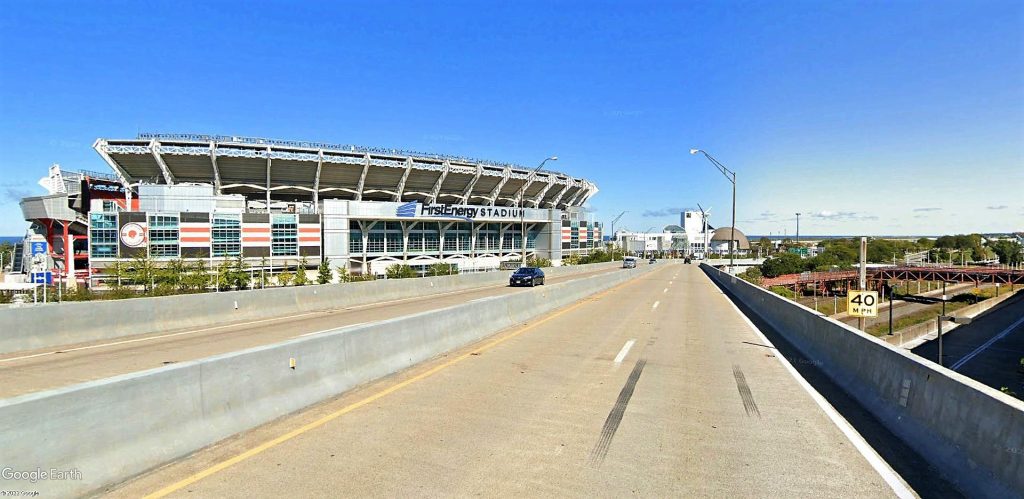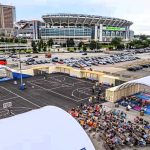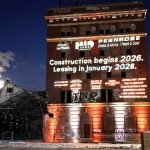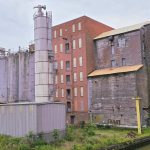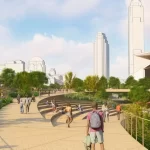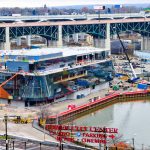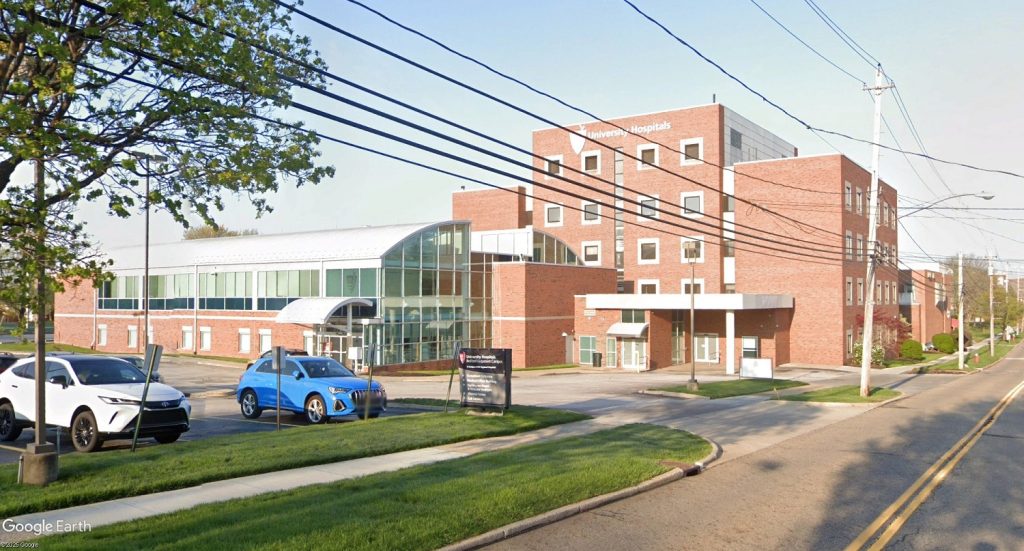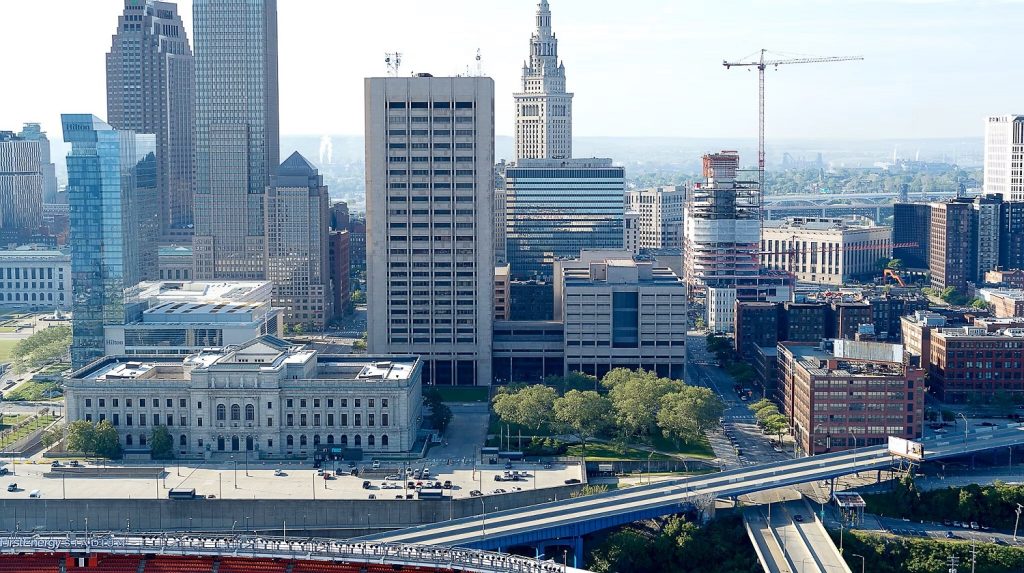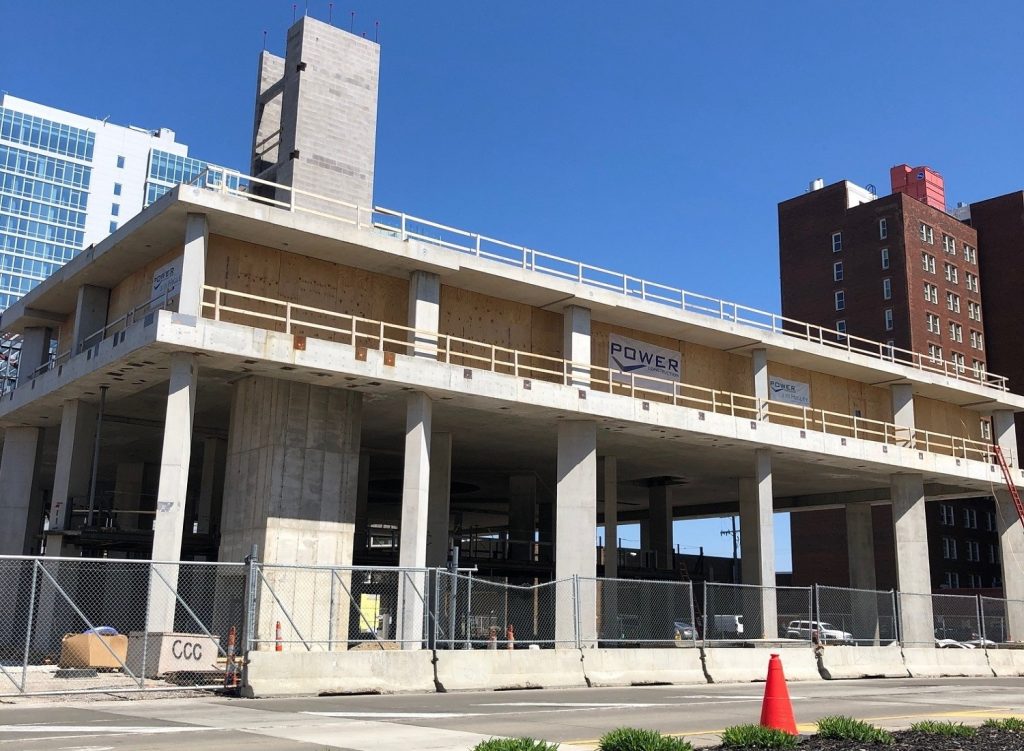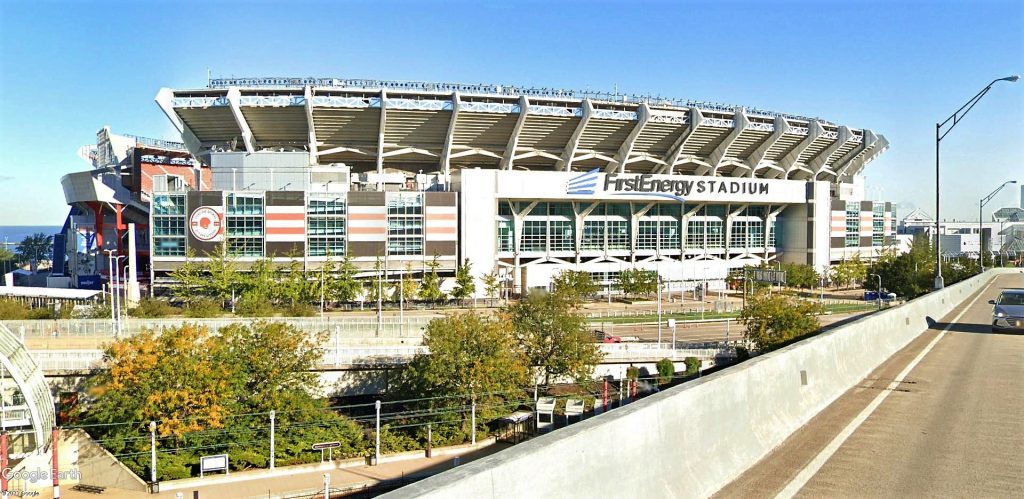
The Cleveland Browns are working to determine whether a structural redesign of the 67,895-seat FirstEnergy Stadium may be in order to bring the city-owned facility up to the standards of peer National Football League venues. If a study now underway proves that to be not feasible, as some Browns executives reportedly expect, then the Browns will consider options for a new stadium (Google). CLICK IMAGES TO ENLARGE THEM
Team denies reports, says focus is on FES
A third source has now communicated with NEOtrans that the Cleveland Browns favor a new, retractable roof stadium built off the lakefront but in or near downtown. And this source is a high-ranking official within the National Football League team itself. Despite this, a team spokesman angrily denied the report and called the source “not credible.”
The source, who spoke on the condition of anonymity, confirmed NEOtrans’ recent article that the Browns are leaning toward building a new facility but said the team hasn’t spent much time or effort looking at new stadium sites yet. The source offered greater detail than the other two sources regarding the limitations of the existing FirstEnergy Stadium and what amenities and attributes the team wants in a new facility.
Specifically, the source said the Browns don’t want to remain at city-owned FirstEnergy Stadium after the team’s lease expires at the end of 2028 nor do they want a new stadium on the lakefront. Instead, the team and its owners, the Haslam Sports Group owned by Jimmy and Dee Haslam, reportedly want an all-purpose facility with a retractable roof and have toured other new NFL stadiums to gather information on their facilities and amenities including site specifications, seating, personal seat licenses, suites, naming rights, public and private financing, food/beverage offerings, interactive features, parking, plazas, adjacent uses like hotels and restaurants, and more.
They’ve also studied the prospects for development next to the football stadium, including monetizing the pre- and post-game festivities, plus value-capture of lakefront development that can help finance a new stadium. The Browns reportedly hired M. A. Mortenson Company of Minneapolis to assist them in these efforts but neither the Browns or Mortenson would confirm that. An e-mail sent to Mortenson Development, Inc. President Mark Sherry was referred by him to Logan Gerken, vice president and general manager of Mortenson’s Sports Group for comment. Gerken did not reply to the e-mail.
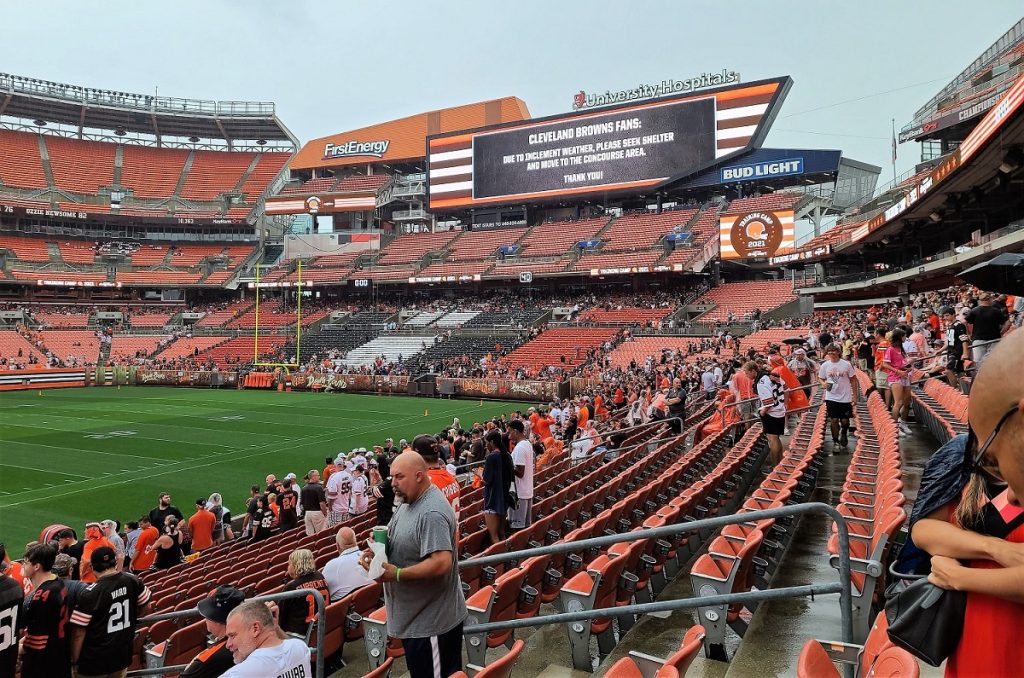
FirstEnergy Stadium was renovated most recently in 2014 at a cost of $120 million, or $150 million in today’s dollars. In four years, after the Buffalo Bills open their new stadium, Cleveland’s will be the 10th-oldest in the National Football League which includes stadiums in Chicago and Green Bay that are technically older but were more thoroughly renovated in the 21st century than Cleveland’s (KJP).
The reason against a lakefront stadium site, according to the source, is that lakefront land is considered too valuable and its 20-acre site too constrained for an NFL-sized stadium and should be redeveloped with mixed uses such as housing, recreation, shops, restaurants, hotels and offices. In fact, the source specified high-rise residential even though it cannot be built right now because of the proximity of Burke Lakefront Airport. But the city hired CHA Consulting to study what it would take to close the underused, federally designated reliever airport. The results of that study are due next year.
The timing of that study may also coincide with the completion of the Browns’ feasibility study of renovating FirstEnergy Stadium which is also due to be finished in 2023. In fact, the Browns’ source acknowledged that NEOtrans’ June 17 article was “probably a year early” especially since it got into a discussion of two optional sites for a new stadium. The source confirmed one of those two locations — at the current 36-acre site of the Cleveland Main Post Office, 2400 Orange Ave., southeast of downtown. The U.S. Postal Service already is leasing 400,000 square feet of space at the former General Motors-Chevrolet Transmission Plant in Parma to help handle Cleveland-area shipments.
An NFL source familiar with the Browns’ stadium matters said the the other site being considered would overlook the municipal parking lots on the northeast edge of downtown. While allowing greater pedestrian connectivity and integration with downtown, the site would require the acquisition of dozens of properties and the demolition of almost as many structures.
However, a handful of those are slightly larger and government-owned and/or operated properties including the city-owned Carl B. Stokes Public Utilities Building, Cleveland Printing Division, a vacant property to be reused for public safety purposes at 1825 Lakeside Ave., Cleveland High School For Digital Arts, Cuyahoga County Board of Developmental Disabilities, and the Federal Bureau of Investigation-Bureau of Alcohol Tobacco Firearms & Explosives.
Peter John-Baptiste, senior vice president of communications for the Browns and Haslam Sports Group, said in an e-mail to NEOtrans that any source who is discussing the team’s stadium plans, other than those involving FirstEnergy Stadium, is being misleading.
“Someone is giving you inaccurate information or pushing their own agenda,” said John-Baptiste. “What you are describing is not the thinking of the Browns or the Haslams. You are being misled. There might be someone out there that believes this to be true but they are dead wrong if they are attributing this premise to the thoughts of our organization.”
He said the Browns’ feasibility study that is being conducted will help guide the team going forward and is focused on renovating FirstEnergy Stadium as part of the lakefront vision. The vision is focused on constructing a $200+ million land bridge over the lakefront railroad tracks owned by Norfolk Southern Corp. and the Greater Cleveland Regional Transit Authority (GCRTA). Because of the elevation of the Shoreway (Ohio Route 2) and its physical barrier between downtown and the lakefront, the city and the Northeast Ohio Areawide Coordinating Agency are studying whether to remove the road’s flyover bridge next to FirstEnergy Stadium and redirect its relatively light traffic to a revamped Shoreway Boulevard.
“Contrary to recent speculation, a recent feasibility study we launched does not contemplate a new stadium or showcase new stadium sites,” the Browns said in a statement it released last week in response to NEOtrans’ previous article on the subject. “A significant stadium renovation at our current site is the premise of the study as well as a focus on how to provide accessibility to the lakefront, drive density and create a 365-day destination major development opportunities that would include new public parks, retail, office, experiential and residential spaces.”
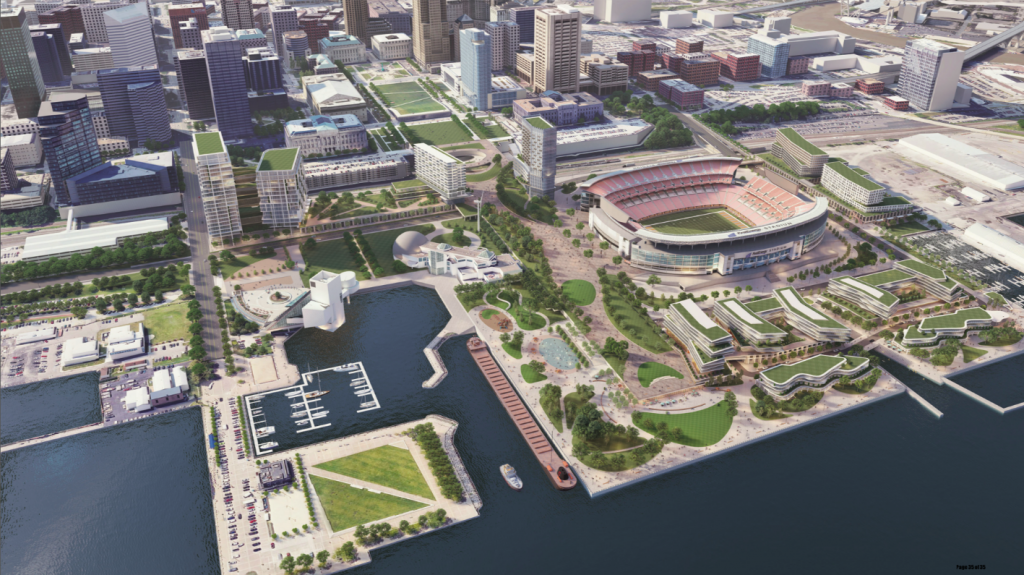
Artist’s rendering of a redeveloped downtown Cleveland lakefront surrounding FirstEnergy Stadium. The revenues from that development could help finance stadium renovations. Or, if the stadium were no longer there and replaced by a new one inland, added development on the 20 acres of opened-up lakefront land could provide more resources to finance that new stadium, sources said (AoDK).
In a follow-up phone call last week, John-Baptiste said the stadium study will evaluate the costs of renovating the complex to bring it up the standards of peer facilities around the NFL. That includes features like improved seats, suites, improved vendor spaces, interactive features, scoreboards/video systems, wider interior concourses and broader plazas around the stadium. It will probably also include some analyses of what it would take to add a retractable roof. All of those components will include a cost estimate attached to it.
And, according to the Browns source, some of it will likely be considered not feasible and/or not cost-effective. FirstEnergy Stadium was built quickly and cheaply on the footprint of old Municipal Stadium. The rushed job of getting a modern, competitive football stadium built was the mission of then-Mayor Michael R. White who rejected the advice of other city officials who urged the football stadium be built just south of the Inner Belt highway, near the Main Post Office. But that couldn’t be done until 2000. After owner Art Modell moved his team to Baltimore following the 1995 season, White was under political pressure to return the new Browns to the field before before the end of the 1990s. The only way to meet that goal was to build the new stadium quickly on the foundations of the old stadium.
The Browns source said that anyone who walks through FirstEnergy Stadium today can see that it hasn’t aged well. And anyone who has visited other NFL stadiums built in the last decade can see the comparative shortcomings of Cleveland’s NFL stadium, the source said. After Buffalo opens its new, $1.4 billion, outdoor stadium, FirstEnergy Stadium will be the NFL’s 10th-oldest stadium in the 32-team NFL that includes Chicago’s Soldier Field and Green Bay’s Lambeau Field. Both were renovated in 2003 for $1.1 billion and $511 million, respectively, in today’s dollars. FirstEnergy Stadium was renovated in 2014 for $120 million, or $150 million today. It is about to undergo $10 million worth of emergency repairs funded almost entirely by city and county taxpayers, according to the Browns’ lease
END

